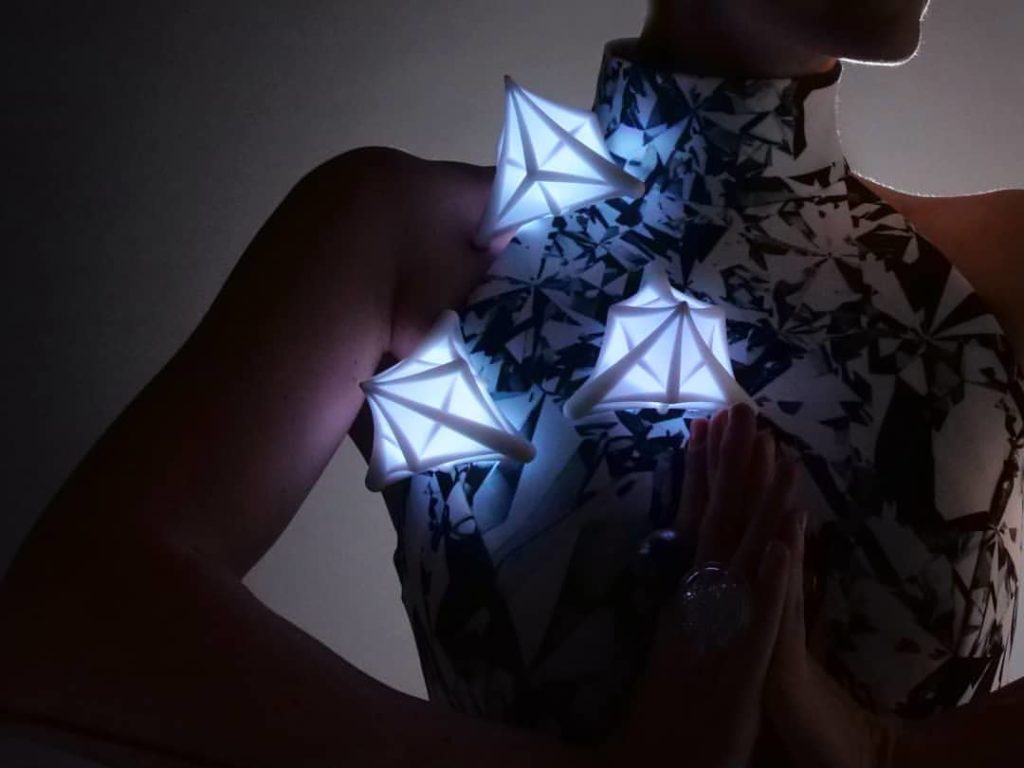Known for creating fashion designs that move, breathe and react to the environment, Anouk Wipprecht revealed her latest piece: the interactive 3D printed Meteor Dress. The outfit is packed with LEDs that light up every time a meteor hits the night sky and burns through the Earth’s atmosphere. Created in celebration of the virtual space party Yuri’s Night, the Meteor Dress runs a Python script driven by space data. From the signature aesthetics to the upscale combination of science, engineering, and fashion, Wipprecht’s piece is a creative challenge.
The dress weaves together illuminating, 3D printed parts that light up when meteoroids fall through a sampling of real-life meteor data, generating meteors at the given rate and the correct brightness distribution as it would have been observed in the sky. Inspired by the Dutch designer’s technological couture DNA, the Meteor Dress showcases her know-how of engineering, robotics, science, and user interaction experiences designed to transcend mere garment appearances.
Since launching her work in 2007, Wipprecht has been partnering with tech giants like Intel, Autodesk, Google, Microsoft, and Audi, as well as leading 3D printing innovators Materialise and Shapeways, to research and develop how future technologically embedded wardrobes would look like. By combining robotics, sensors, machine learning, and artificial intelligence (AI), she is developing interactive couture, wearable devices, and smart textiles.
This latest addition to her collection is not just one of a kind, but genuinely resembles a vision of the night sky during a meteor shower. The Miami-based designer teamed up with Co-Founder of Yuri’s Night and Virgin Galactic advisor Loretta Hidalgo Whitesides to come up with the idea for the dress. Then she turned to Denis Vida, a meteor physics graduate researcher and software engineer at Ontario’s Western University who is building a global network of video meteor cameras called the Global Meteor Network. According to a Twitter post by Vida, the dress will be premiered during Yuri’s Night world space party on April 12, 2021, worn by organizer Hidalgo Whitesides.
Like every year since 2001, Yuri’s Night commemorates milestones in space exploration. The 2021 virtual event coincides with the 60th anniversary of Yuri Gagarin’s first trip to space. In honor of the event, an all-star cast of space heroes, scientists, artists, and musicians will honor the turning point in space exploration. The organizers will hold a free global livestream event beginning at 7:00 pm eastern time on April 10, two days before the actual anniversary.
With an interest in increasing garment digitalization, Wipprecht’s collection includes vanguard pieces imagined for the emerging field of fashion technology, which is characterized by niche segments like 3D printed couture, high-tech fabrics, and wearable technologies. The innovator has suggested that fashion currently lacks microcontrollers. To solve this challenge, she likes to embed sensors in her designs that monitor the space surrounding the wearer.
Similarly, body sensors included in her high-tech garments control the person’s stress levels, such as comfort or anxiety. A perfect example of this aesthetic is the laser-sintered Intel-Edison-based “Spider Dress.” It is one of her most publicized pieces since it incorporates sensors and moveable arms helping create a highly defined boundary of personal space. When these sensors notice the wearer’s respiration heightening and the looming proximity of another person, the mechanical limbs move up to an attack position and then retract.
Projected as “host” systems around the body that tend towards AI, Wipprecht’s exceptional designs are inspired by nature. Even the names were chosen as a tribute to some of the most complex creatures on the planet, like spiders, octopuses, and pangolins. Although her latest Meteor Dress evokes streams of cosmic debris that light up the sky, it is not her first experience recreating a natural phenomenon. In 2020, the designer showcased a “Smoke Dress” that elicits “visions of interstellar nymphs frolicking in Neptune’s ice caves.” This time, Belgium’s natural underground caves inspired a unique piece that camouflages itself with smoke whenever someone is approaching.
Proximity is clearly one of the overarching themes for the tinkerer, along with advanced technologies and some of nature’s greatest defense mechanisms. Wipprecht’s futuristic take on fashion concepts is meant to redefine garment trends, intended to match advances in technology with 3D printable materials and fabrics. The space data concept behind her Meteor Dress could transcend time, as updates of new information about meteors is fed to the system. Moreover, the synchronous meteor tracking idea could be the start of a trend at the intersection of fashion and science.
